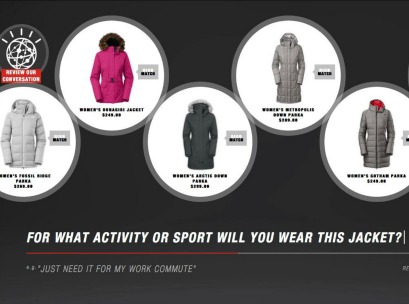 Artificial intelligence (AI), cognitive computing and machine learning were all on display at the NRF Big Show in New York earlier this year.
Artificial intelligence (AI), cognitive computing and machine learning were all on display at the NRF Big Show in New York earlier this year.
IBM’s Watson, named after the company’s first CEO, is the most prominent example of use cases for AI in retail.
Outdoor sportswear brand, The North Face, has developed an online shopping tool using IBM’s Watson to replicate the conversations has instore while shopping online.
“We jumped at the chance to try and harness IBM’s Watson technology to see what we could do to change online shopping,” said Cal Bouchard, senior director of e-commerce at The North Face. “And the key word in there is ‘change’.”
For decades online shopping has revolved around a grid of products on a webpage, on a white background, with tools to search and filter.
“We really wanted to create something new and different – something that was personal and intuitive and something that really allowed our customers to speak in their natural voices, in their natural language and tell us what they wanted and what they needed,” Bouchard explained.
The North Face team built a tool called Fluid XPS powered by IBM Watson, which delivers dialogue-driven product recommendations.
The experience starts with a question: Where and when will you be using this jacket? Users are prompted to write a full sentence (“We don’t want keyword jockeys,” Bouchard said) and the platform begins by narrowing down products by conditions and gender. A series of questions are designed to let consumers see the product selection change as they provide more information. (You can try it out here).
The North Face started beta testing in November 2015 with consumers who they thought were having the most trouble with the site, the ones that arrived at the jackets landing page clicked through to a few products, weren’t finding what they wanted and then went back to the jackets page.
Phase two was tested with their best customers, based on their loyalty program.
Now a permanent fixture of the jackets landing page, between mid-November and mid-January 2016, 50,000 users used the tool, for an average of two minutes per session, Bouchard said.
“This was something really important to us. Going in as a brand, and as a premium brand, we want to compete on content and on experience, not ever on price. So engagement with our product and brand, no matter where the purchase happens is really important to us. Our site averages just over five minutes of time per visit, so adding two minutes was a really important and significant number for us.”
The North Face also surveyed users after the experience – 75 per cent said they would use it again.
“I think what this tells you is consumers are ready for some kind of AI online shopping experience,” Bouchard said.
One piece of advice Bouchard shared was that AI requires a lot of teaching. For example, the system needed to learn that Tahoe is ski resort, temperature is a measure of degrees and running is the same thing as jogging.
“You have to think that you’re not going to get anything when you get this, and you have to ingest a lot of data into it,” Bouchard said.
Retailers also need to “go deep” on their product catalogues, recording all the features and weighing them against how important it is to your customer.
“AI needs to know your product,” Bouchard explained. “And it will never know your product unless you really know your product.”
Neil Patil, president of software products group for Fluid Inc, which developed the platform with The North Face, said it is about making the online shopping experience, “more human”.
“We focused on this notion that there is a conversation being had instore and we should take that conversation and bring that online,” Patil said.
This article was originally published in Inside Retail’s February magazine, click here to subscribe.






